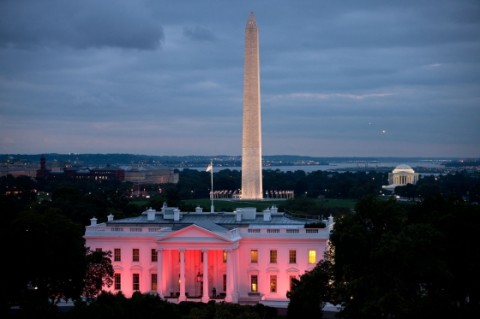A guest column Kathleen Sebelius, Secretary of Health and Human Services
![hhs-logo[1]](https://www.clarksvilleonline.com/wp-content/uploads/2011/10/hhs-logo1-195x200.jpg) Washington, DC – October is National Breast Cancer Awareness Month – a time to remember those who have lost their lives to breast cancer and those who are battling it now, and to celebrate with those who have survived. It is also a time to reaffirm our commitment to fighting breast cancer and to remind ourselves of the importance of prevention and early detection.
Washington, DC – October is National Breast Cancer Awareness Month – a time to remember those who have lost their lives to breast cancer and those who are battling it now, and to celebrate with those who have survived. It is also a time to reaffirm our commitment to fighting breast cancer and to remind ourselves of the importance of prevention and early detection.
Breast cancer remains one of the most frequently diagnosed cancers among American women and despite remarkable advances in treatment and prevention, it remains the second leading cause of cancer death.
[youtube]http://www.youtube.com/watch?v=0_vZUhRXqns[/youtube]
Regular mammography screenings help ensure that breast cancer does not take the lives of more women. The chance of successful treatment is highest when breast cancer is detected early. However, only about 67 percent of women aged 40 or older have had a mammogram in the last two years. If 90 percent of women 40 and older received breast cancer screening, 3,700 lives would be saved each year. Yet in a time when budgets are tight, costs – even moderate co-pays – deter many patients from receiving these important screenings.
Thanks to the health reform law, the Affordable Care Act, most private health plans and Medicare now cover women’s preventive health care – such as mammograms and screenings for cervical cancer –with no co-pays or other out-of-pocket costs. This means that women can get services they need to detect or prevent breast cancer before it spreads or becomes fatal, without worrying that they’ll have to pay for these services out of their own pockets. This year to date, 3.8 million women in traditional Medicare have gotten a free mammogram.
In addition to regular mammography screenings, there are steps that women can take that may reduce their risk of developing breast cancer. Women should talk with their doctor about their personal risk for breast cancer, when to start having mammograms, and how often to have them. If they are found to be at increased risk of breast cancer because of medical or genetic history, they should talk with their doctor to decide what the best options are to reduce their breast cancer risk. With the release of the new Women’s Preventive Services Guidelines, a well-woman visit is available so women have the opportunity to discuss their health care needs with their medical provider—at no additional cost.
Women also have new rights and protections against insurance company abuse under the Affordable Care Act. If diagnosed with breast cancer or another illness, women are now protected from having their coverage taken away if they get sick and when they need coverage the most.

The health reform law is also helping women who are going, or have gone through, costly breast cancer treatment. Today, insurance companies can’t impose lifetime limits on coverage. And in most health plans, annual limits will be restricted. This means that your health insurance will be there right with you, covering your treatments, as long as you need it.
Beginning in 2014, it will be illegal for insurance companies to discriminate against anyone with a pre-existing condition. In the past, insurance companies could deny coverage to women due to pre-existing conditions such as breast cancer, and if coverage was attained, insurance companies set lifetime and annual limits on what the companies would spend for benefits.
These changes are making real differences in the lives of American women and families. Prevention, coupled with continued research, will help save more lives and improve the quality of life for all of us touched by breast cancer.
Presidential Proclamation
U.S. President Barack Obama released a Presidential Proclimation on October 3rd to mark National Breast Cancer Awareness Month.

 This month, pink ribbons will be displayed around our country, adorning jackets and public spaces alike. A sign of solidarity, these ribbons remind us of our commitment to preventing and treating breast cancer, and to supporting those courageously battling this disease. Countless Americans will participate in events to raise awareness alongside survivors and their families, working together to support research that will save lives.
This month, pink ribbons will be displayed around our country, adorning jackets and public spaces alike. A sign of solidarity, these ribbons remind us of our commitment to preventing and treating breast cancer, and to supporting those courageously battling this disease. Countless Americans will participate in events to raise awareness alongside survivors and their families, working together to support research that will save lives.
We have come far in recent decades in the prevention, early detection, and treatment of breast cancer. Still, this year, hundreds of thousands of women will be diagnosed with breast cancer, and too many will be lost. African-American women bear a particularly large burden, experiencing higher death rates from breast cancer than other racial or ethnic groups in the United States. Too many men also develop and fall victim to this cancer.
It is important to understand the risks and precautions associated with breast cancer. Some risk factors, like obesity, are avoidable. Other factors, like family history, are not avoidable, but knowledge of them can help inform medical decisions. Taking protective steps like getting regular check-ups, maintaining a healthy body weight and balanced diet, and exercising may help lower the chances of developing breast cancer. I encourage all Americans to talk to their doctors about breast cancer, and to visit www.Cancer.gov to learn more about symptoms, diagnosis, and treatment.
Screening and early detection are essential to fighting this disease, yet only about two-thirds of American women over 40 have had a mammogram in the last 2 years. But now, thanks to the Affordable Care Act, all Americans joining new health-care plans can receive recommended preventive services, including annual mammograms for women over 40, with no out-of-pocket costs. This new benefit would also ensure that women in new insurance plans who are at high risk for breast cancer are covered when they speak with their clinicians about ways to prevent or delay the development of cancer. The Affordable Care Act also established a committee tasked with advancing awareness and prevention of breast cancer among young women.
This month, we join together in honoring the women and men lost to breast cancer. In their memory, we recommit to supporting the hard-working researchers, health-care providers, advocates, and organizations dedicated to treating and curing this devastating disease. We embrace our mothers, daughters, sisters, and loved ones currently battling breast cancer, along with their friends and families, and we resolve to one day defeat it.
NOW, THEREFORE, I, BARACK OBAMA, President of the United States of America, by virtue of the authority vested in me by the Constitution and the laws of the United States, do hereby proclaim October 2011 as National Breast Cancer Awareness Month. I encourage citizens, government agencies, private businesses, nonprofit organizations, and all other interested groups to join in activities that will increase awareness of what Americans can do to prevent and control breast cancer.
IN WITNESS WHEREOF, I have hereunto set my hand this third day of October, in the year of our Lord two thousand eleven, and of the Independence of the United States of America the two hundred and thirty-sixth.


